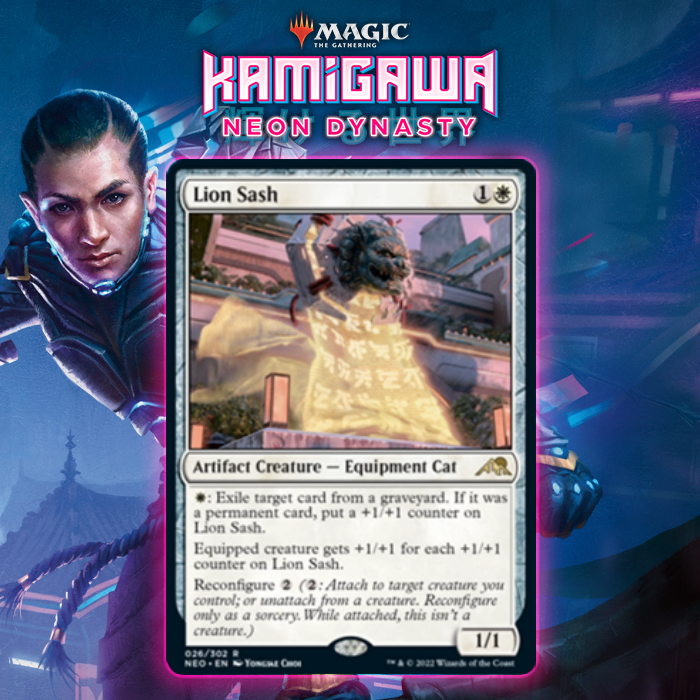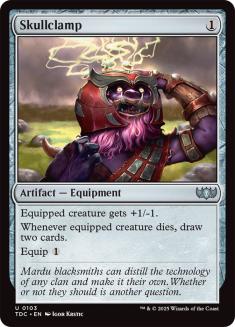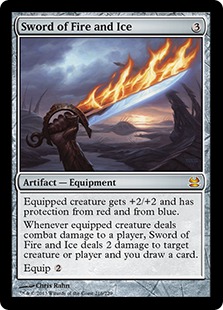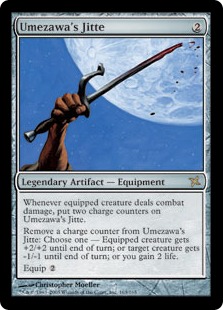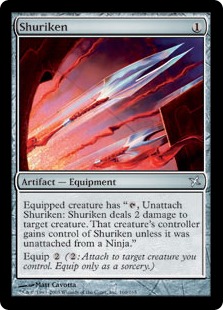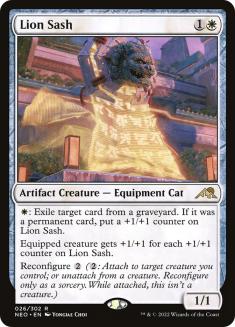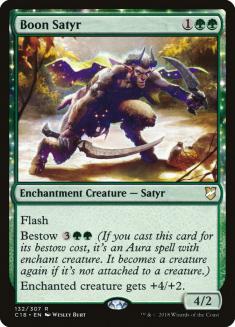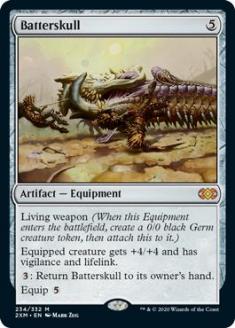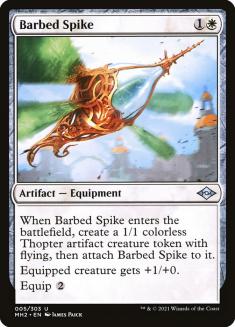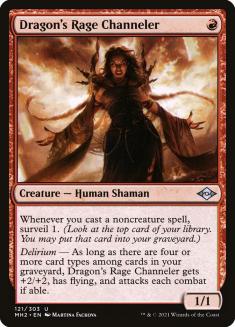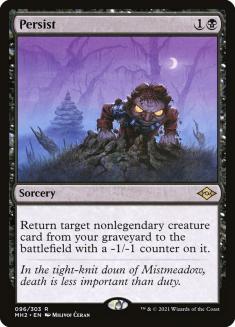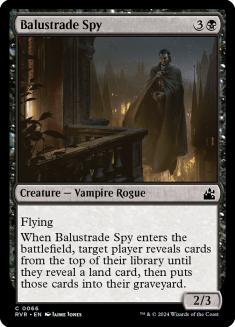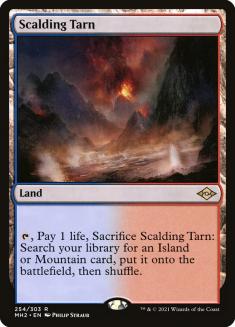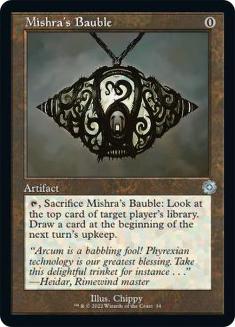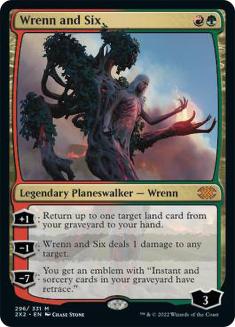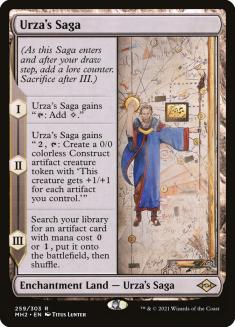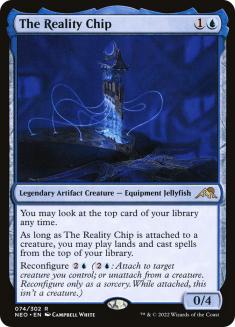The Evolution of Equipment
It took some time to figure out Equipment. The original Mirrodin block not only came close to killing Magic (for real this time!) and gave the new card frame its black-border debut, it introduced a new artifact subtype, Equipment, that soon became evergreen.
This first batch was a mixed bag. Skullclamp was an existential threat to Magic’s survival, while the Darksteel Swords were a home run that have fans clamouring for the anti-Dimir and anti-Gruul Swords to complete the full cycle after eighteen years.
Hot off the heels of Mirrodin, Kamigawa was expected to forge some new Equipment. Umezawa’s Jitte was an egregious mistake and there is some forgettable Equipment throughout the block, but Shuriken was an early case study in how to design thematic and interesting Equipment.
Just like Kamigawa itself, Equipment has advanced massively since then:
Equipment, Reconfigured
The reconfigure mechanic is the latest attempt to address the inherent risks and diminishing returns of creature enhancements, bundled together in this set as modifiers for cards like Kodama of the West Tree. If you can’t keep a creature around, what’s the point? Drawing too many copies of even the best nonlegendary Equipment is unfortunate; drawing multiple Lion Sashes may be unfortunate in other ways but avoids this downside.
Reconfigure is most analogous to a reverse bestow from Theros block. You pay the base rate for the creature and then get to pay extra for the enhancement later. Some of the flashier reconfigure cards unlock an extra functionality once attached to a creature; Lion Sash is always the same in that sense but scales in a way that few of these cards do.
The reconfigure cards have their own unique risk that inverts the downside of typical Equipment. As creatures themselves they are vulnerable to removal. The upside of powerful Equipment is that it can turn even the worst creature into a substantial threat. This becomes a design flaw if taken too far; the game becomes more about having any creature than good ones. It’s easier to remove than creatures than noncreature artifacts, so opponents will often struggle to deal with the real problem. Equipment that starts as a creature lacks that protection. An opponent can point their Unholy Heat at Lion Sash and move on.
This new model of Equipment is intriguing, but the text box on Lion Sash is what catches the eye. It has a promising precedent.
The Scavenging Ooze Effect
Scavenging Ooze has been a constant feature of several non-rotating formats and a staple in any sensible Standard format it appears in. If the game is about casting a gigantic Expansion // Explosion or Primeval Titan, Ooze is too small-ball, but Ooze excels in any game of honest Magic. That’s a fair expectation for Lion Sash too.
The differences are important, though. Scavenging Ooze is good at stabilizing against aggressive decks. Every life point counts when you are under that pressure. Every point of toughness is essential when you need to control the biggest creature on the battlefield. Sinking mana into Lion Sash for a smaller creature with no life buffer won’t rescue you in some games Ooze might have won.
Green is also better-suited to growing Scavenging Ooze. Consider the Elvish Mystic + Llanowar Elves decks in Pioneer or the Birds of Paradise + (Ig)noble Hierarch decks in Modern. Your mana creature will often die on sight, giving Ooze some early food. If it survives, you are more likely to have spare mana later to spend on Ooze. With more mana it’s easier to remove an opposing creature (or do something that involves sacrificing your own or placing one in your graveyard) and eat it immediately.
The Question of Speed
Ooze’s hungriness for mana is an issue in faster formats where the graveyard-centric decks can win before you have mana left for Ooze or shrug off one or two activations. Your Turn 2 Scavenging Ooze on the draw against Esper Reanimator or Oops All Spells may be too slow unless boosted by mana acceleration. Ooze is an excellent way to slam the door shut once you have some breathing room, but it’s unreliable as your first relevant play of the game. Lion Sash is even slower in these contexts.
For this reason, Lion Sash doesn’t let you skimp on other graveyard hate. Still, just as the first Scavenging Ooze makes every Chord of Calling better in those matchups, the first Lion Sash gives Stoneforge Mystic a new and unique flexibility at the low cost of a single slot.
Lion Sash is much less fussy than Ooze about what it eats. It’s easy to run out of creatures that grow Ooze. By contrast, it’s difficult to run out of permanents that grow Sash, especially in a format with fetchlands (which you can load up on yourself even in a mostly monocoloured deck). Major and minor graveyard interactions are everywhere in Modern. Gobbling up fetchlands or Mishra’s Bauble to break up delirium or prevent a Murktide Regent at a profit is a big strength of Sash.
Lion Sash in Historic
Artifact-heavy decks with a lot of creatures to pick up Lion Sash are floating around most mid-sized Constructed formats. Let’s start with Historic:
Creatures (22)
- 4 Ornithopter
- 2 Stonecoil Serpent
- 4 Esper Sentinel
- 4 Thought Monitor
- 4 Ingenious Smith
- 2 The Reality Chip
- 2 Lion Sash
Lands (21)
Spells (17)

The Azorius Artifacts shell popularized by Aaron Gertler is a natural home for the new powerful Equipment. Lion Sash offers a good incentive to cut some of the clunkier cards from the shell anyway. Reverse Engineer is a fine card draw spell for what it is, but Kamigawa: Neon Dynasty offers an exciting alternative:
The base case of The Reality Chip, a good blocker that can pick up other Equipment or enable artifact synergies, is acceptable. The ceiling, the cheapest Future Sight ever that meshes perfectly with your deck, is incredibly high. The Equipment we’re supposedly here for, Lion Sash, is less flashy but is good insurance against the various graveyard nonsense in Historic and another solid threat.
Lion Sash in Pioneer
In Pioneer, Lion Sash lets us focus on artifacts within a single colour:
Creatures (28)
- 4 Ornithopter
- 4 Thraben Inspector
- 4 Toolcraft Exemplar
- 4 Gingerbrute
- 4 Stonecoil Serpent
- 4 Ingenious Smith
- 4 Lion Sash
Lands (22)
Spells (10)

A deck like this has less raw power than Azorius Ensoul. In return, it enjoys a clean manabase rather than a shaky one.
Lion Sash in Modern
The preceding lists are adjustments to fringe decks in their formats. In Modern, we find not just a deep trough of fetchlands for Lion Sash to feast on but a proven top-tier deck based around artifact creatures and Equipment:
Creatures (24)
- 4 Ornithopter
- 4 Stoneforge Mystic
- 3 Memnite
- 4 Puresteel Paladin
- 3 Giver of Runes
- 4 Esper Sentinel
- 1 The Reality Chip
- 1 Lion Sash
Lands (22)
Spells (14)

Azorius is the rarest colour combination for the Hammer archetype, but this list takes up the blue splash to explore The Reality Chip, a card advantage engine that is tutorable here with Stoneforge Mystic (and Steelshaper’s Gift, which is a little more appealing with the added flexibility of Chip and Lion Sash) and recurrable with Lurrus of the Dream-Den. Though neither interaction is immediately obvious, the reconfigure cards do crucially work with both Sigarda’s Aid and Puresteel Paladin.
There are some other homes in this space for the Lion Sashes of the world. Modern phenomenon Aspiringspike raised some eyebrows with a more midrange artifact deck based around Oswald Fiddlebender:
Creatures (22)
- 4 Stoneforge Mystic
- 1 Spellskite
- 4 Goblin Engineer
- 4 Ragavan, Nimble Pilferer
- 1 Breya's Apprentice
- 4 Esper Sentinel
- 4 Oswald Fiddlebender
Lands (22)
Spells (16)

The change here is clear and minimal: find room for a single Lion Sash and have consistent access to it as a result.
Puresteel Paladin
One of his more recent creations suggests another direction:
Comparing these decks made me wonder about the possibility of a ‘fair’ Puresteel Paladin deck. The printing of Lion Sash was all I needed to put that together:
Creatures (22)
- 4 Stoneforge Mystic
- 4 Puresteel Paladin
- 4 Fervent Champion
- 4 Ragavan, Nimble Pilferer
- 4 Esper Sentinel
- 2 Lion Sash
Lands (24)
Spells (14)

This deck lacks the raw speed of Colossus Hammer but is perhaps more stable in a world where the backlash against Hammer has almost dropped it from Modern’s top tier. Every creature here is high-impact and the Equipment make it much easier to connect with Ragavan, Nimble Pilferer.
The need for artifacts to reach metalcraft for Puresteel Paladin pushes you towards Nettlecyst, a fantastic threat in its own right and a fine pairing with Fervent Champion or Paladin, and encourages perhaps the best card in Modern in Urza’s Saga. There are more good Equipment now than you have room for – it’s almost certainly a mistake for a Stoneforge Mystic deck not bound by Lurrus to omit Kaldra Compleat! – but I find this exciting as a proof of concept.
Lion Sash is what any new technology should be: an interesting improvement on previous designs that gets your mind whirring as you try to figure out its potential.

